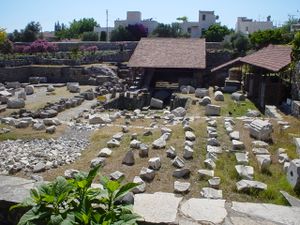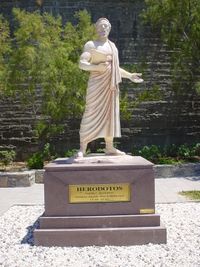هاليكرناسوس
Ἁλικαρνασσός or Ἀλικαρνασσός (يونانية قديمة) Halikarnas (لغة تركية) | |
 The ruins of the Mausoleum of Maussollos, one of the Seven Wonders of the Ancient World. | |
| المكان | Bodrum, Muğla Province, Turkey |
|---|---|
| المنطقة | Caria |
| الإحداثيات | 37°02′16″N 27°25′27″E / 37.03778°N 27.42417°E |
| النوع | Settlement |
| التاريخ | |
| مقترن بـ | Herodotus |
Halicarnassus ( /ˌhælᵻkɑːrˈnæsəs/; باليونانية قديمة: Ἁλικαρνᾱσσός Halikarnāssós or Ἀλικαρνασσός Alikarnāssós; تركية: Halikarnas) was an ancient Greek city at what is now Bodrum in Turkey. It was located in southwest Caria on a picturesque, advantageous site on the Ceramic Gulf.[1] The city was famous for the Mausoleum of Halicarnassus, also known simply as the Tomb of Mausolus, whose name provided the origin of the word "mausoleum". The mausoleum, built from 353 to 350 BC, ranked as one of the seven wonders of the ancient world.
Halicarnassus' history was special on two interlinked issues. Halicarnassus retained a monarchical system of government at a time when most other Greek city states have long since gotten rid of their kings. And secondly, while their Ionian neighbours rebelled against Persian rule, Halicarnasassus remained loyal to the Persians and formed part of the Persian Empire until Alexander the Great captured it at the siege of Halicarnassus in 334 BC.
Halicarnassus originally occupied only a small island near to the shore called Zephyria, which was the original name of the settlement and the present site of the great Castle of St. Peter built by the Knights of Rhodes in 1404. However, in the course of time, the island united with the mainland, and the city was extended to incorporate Salmacis, an older town of the Leleges and Carians[1] and site of the later citadel.
أصل الاسم
The suffix -ᾱσσός (-assos) of Greek Ἁλικαρνᾱσσός is indicative of a substrate toponym, meaning that an original non-Greek name influenced, or established the place's name. (Compare Parnassus.) It has been recently proposed that the element -καρνᾱσσός is cognate (essentially two words in different languages derived from the same original source) with Luvian (CASTRUM)ha+ra/i-na-sà / (CASTRUM)ha+ra/i-ni-sà 'fortress'.[2] If so, the toponym is probably borrowed from Carian, a Luwic language spoken alongside Greek in Halicarnassus. The Carian name for Halicarnassus has been tentatively identified[ممن؟] with Alos-δ karnos-δ in inscriptions.
التاريخ
الوجود الموكني في المنطقة
Some large Mycenaean tombs have been found at Musgebi (or Muskebi, modern Ortakent), not far from Halicarnassus. According to Turkish archaeologist Yusuf Boysal, the Muskebi material, dating from the end of the fifteenth century BC to ca. 1200 BC, provides evidence of the presence, in this region, of a Mycenaean settlement.[3]
More than forty burial places dating back to that time have been discovered. A rich collection of artifacts found in these tombs is now housed in the Bodrum Castle.
These finds cast some light on the problem of determining the territories of ancient Arzawa and Ahhiyawa.[3]
التاريخ المبكر
Notable people
- Artemisia I (fl. 480 BC), Queen of Halicarnassus, who participated in the Battle of Salamis[4]
- Herodotus (c. 484 – c. 425 BC), Greek historian[5]
- Dionysius (ح. 60 - 8 BC), historian and teacher of rhetoric[6]
- Aelius Dionysius (fl. 2nd century), Greek rhetorician and musician
Notes and references
- ^ أ ب One or more of the preceding sentences incorporates text from a publication now in the public domain: Hogarth, David George (1911). . In Chisholm, Hugh (ed.). دائرة المعارف البريطانية. Vol. 12 (eleventh ed.). Cambridge University Press. pp. 837–838}.
{{cite encyclopedia}}: Cite has empty unknown parameter:|coauthors=(help) - ^ Ilya Yakubovich. "Phoenician and Luwian in Early Age Cilicia". Anatolian Studies 65 (2015): 44, doi:10.1017/S0066154615000010 Archived 2016-09-23 at the Wayback Machine.
- ^ أ ب Yusuf Boysal, New Excavations in Caria (PDF), Anadolu, (1967), 32–56.
- ^ Salowey, Christina A.; Magill, Frank Northen (2004). Great Lives from History: Aaron-Lysippus. Salem Press. p. 109. ISBN 9781587651533.
- ^ Berit, Ase; Strandskogen, Rolf (26 May 2015). Lifelines in World History: The Ancient World, The Medieval World, The Early Modern World, The Modern World. Routledge. p. 62. ISBN 9781317466048.
- ^ Matsen, Patricia P.; Rollinson, Philip B.; Sousa, Marion (1990). Readings from Classical Rhetoric. SIU Press. p. 291. ISBN 9780809315932.
Bibliography
- Cook, B. F., Bernard Ashmole, and Donald Emrys Strong. 2005. Relief Sculpture of the Mausoleum At Halicarnassus. Oxford: Oxford University Press.
- Dinsmoor, William B. (1908). "The Mausoleum at Halicarnassus". American Journal of Archaeology. 12: 3–29, 141–197. doi:10.2307/496853.
- F. Adler, F. (1900). "Das Mausoleum zu Halikarnass" (PDF). Zeitschrift für Bauwesen. 50: 2–19.
- Fergusson, James (1862). The Mausoleum at Halicarnassus restored in conformity with the recently discovered remains. London: J. Murry.
- Jeppeson, Kristian. 2002. The Maussolleion at Halikarnassos: Reports of the Danish archaeological expedition to Bodrum: The superstructure, a comparative analysis of the architectural, sculptural, and literary evidence. Vol. 5. Aarhus, Denmark: Aarhus Univ. Press.
- Newton, Charles Thomas; Pullan, Richard Popplewell (1862–1863). A history of discoveries at Halicarnassus, Cnidus & Branchidæ (2 Vols). London: Day and Son.. Google books: Volume 1, Volume 2.
- Oldfield, Edmund (1895). "The Mausoleum at Halicarnassus. A new restoration". Archaeologia. 54: 273–362. doi:10.1017/s0261340900018051.
- Oldfield, Edmund (1897). "The Mausoleum at Halicarnassus. The probable arrangement and signification of its principal sculptures". Archaeologia. 55: 343–390. doi:10.1017/s0261340900014417.
- Preedy, J. B. Knowlton (1910). "The Chariot Group of the Maussolleum". Journal of Hellenic Studies. 30: 133–162. JSTOR 624266.
- Rodríguez Moya, Inmaculada, and Víctor Mínguez. 2017. The Seven Ancient Wonders In the Early Modern World. New York: Routledge.
- Six, J. (1905). "The pediments of the Maussolleum". Journal of Hellenic Studies. 25: 1–13. doi:10.2307/624205.
- Steele, James, and Ersin Alok. 1992. Hellenistic Architecture In Asia Minor. London: Academy Editions.
- Stevenson, John James (1909). A restoration of the Mausoleum at Halicarnassus. London: B. T. Batsford.
- Wiater, Nicolas. 2011. The Ideology of Classicism: Language, History, and Identity In Dionysius of Halicarnassus. New York: De Gruyter.
- Winter, Frederick E. 2006. Studies In Hellenistic Architecture. Toronto: University of Toronto Press.
وصلات خارجية
| مراجع مكتبية عن Halicarnassus |
- Livius, Halicarnassus by Jona Lendering.
- The Tomb of Mausolus W. R. Lethaby's reconstruction of the Mausoleum, 1908.
- Mausoleum Article from Smith's Dictionary of Greek and Roman Antiquities, 1875.
- Pages using gadget WikiMiniAtlas
- مقالات المعرفة المحتوية على معلومات من دائرة المعارف البريطانية طبعة 1911
- Wikipedia articles incorporating text from the 1911 Encyclopædia Britannica
- Short description is different from Wikidata
- Coordinates on Wikidata
- Articles containing Ancient Greek (to 1453)-language text
- Pages using Lang-xx templates
- Articles with specifically marked weasel-worded phrases from December 2018
- مواقع أثرية يونانية قديمة في تركيا
- Bodrum
- Catholic titular sees in Asia
- Dorian Hexapolis
- Greek colonies in Caria
- History of Muğla Province
- Achaemenid cities
- Halicarnassus
- أعضاء العصبة الدلية

